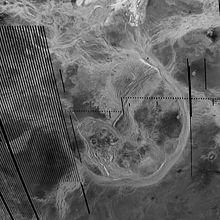Corona (planetology)

In planetology, circular or oval surface structures of celestial bodies that are not impact craters are referred to as corona (plural coronae from Latin “wreath”, “crown”) .
Venus
Coronae were identified for the first time in 1983, when the data supplied by the Venus probe Venera 16 showed with better resolution that the structures previously thought to be impact craters must have formed differently. These are structures whose elliptical edge consists of one or more ring walls, while the complexly structured interior often has radial structures.
Today it is assumed that the Venus coronae arose from bulges caused by mantle plumes , which collapsed in the center when the magma cooled, thus creating the inner structures.
Mainly on the basis of the radar data supplied by the Magellan probe, over 350 more coronae have now been identified on Venus.
Miranda
In the meantime, oval structures known as coronae have also been found on the Uranus moon Miranda . It is believed that it is ice diapire .
literature
- Tilman Spohn, Marile Avermann: Venus. In: Physik in our time, 25 (1994), p. 221f, doi: 10.1002 / piuz.19940250504
- F. Anguita, AF Chicarro: Ovoid structures in the solar system: The coronae of Venus and Miranda, and the domes on the Earth. In: Earth, Moon, and Planets Vol. 53 (1991), No. 2, pp. 109-116, doi: 10.1007 / BF00057426
Web links
- List of Venus and Miranda coronae in the IAU's Gazetteer of Planetary Nomenclature (WGPSN)
